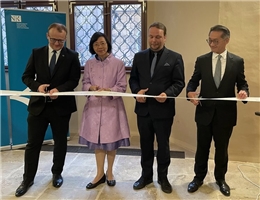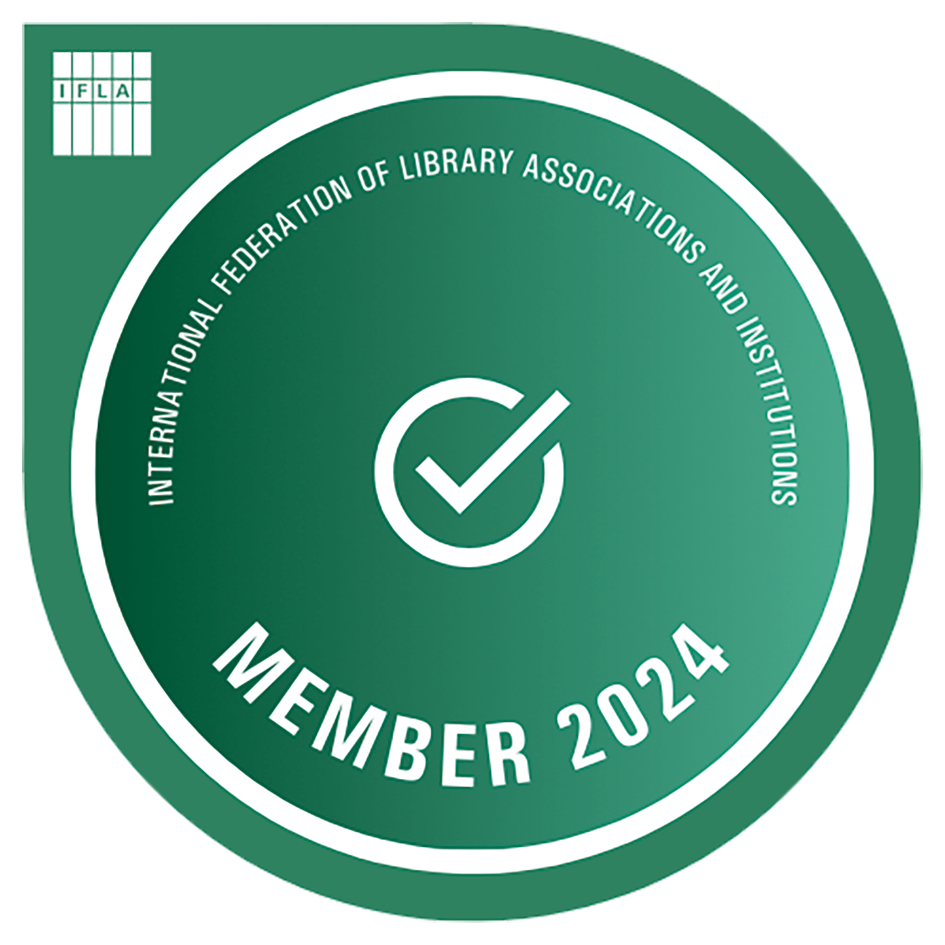News & Events
- 2023-09-12

The aroma of ancient books bade a farewell to the Prague spring and welcomed in the summer months. On June 1, 2023, the National Central Library and the National Library of the Czech Republic teamed up for the first time to cohost the opening ceremony of “The Imprint of Civilization.” The exhibition was available from June 1 to August 31. The theme was “Writing Creates a Civilization,” featuring oracle bone characters, bronzeware rubbings, and other precious replicas. Information was also provided on the developmental history of writing and printing. An “Exquisite Works” section showcased a national treasure, the Yongle Encyclopedia in NCL’s special collections. “Bridging East-West Civilizations” brought together books on astronomy, calendrics, vegetation, and historical geography to showcase how the interaction between the two civilizations since the 17th century has influenced the world. In addition, in a hat-tip to Prague where the exhibition is held this year, a new addition was created for the exhibition called “Exploring the Vestiges of the Czech Republic,” showing references to Bohemia in ancient books. Bohemia is an ancient name for what is now the Czech Republic.
NCL Director-General Shu-hsien Tseng stated that books and reading are the lingua franca of the world. This exhibition is a continuation of NCL’s “The Imprint of Civilization” collaborative exhibition, with past partners including the National Library of Latvia (2015), the National Széchényi Library in Hungary (2016), the National Library of Estonia (2021), and the Biblioteka Narodowa in Poland (2022). “The Imprint of Civilization” seems to have become a brand for Taiwan in international cultural exchange. Due to the amazing reception this exhibition has enjoyed, this is its fifth iteration. It is hoped that through working with the National Library of the Czech Republic, it will open up a more impassioned collaborative relationship between the two libraries and thus achieve the dual aim of promoting literacy and increasing cultural interactions between the two countries.
The exhibition’s opening ceremony was held in what has been called “one of the world’s most beautiful libraries,” the National Library of the Czech Republic. The ceremony began amidst the elegant sounds of flute playing. Ambassador Liang-ruey Ke from the Taipei Economic and Cultural Office in Prague was invited to attend. Ambassador Ke not only thanked the National Library of the Czech Republic for its willingness to cohost the exhibition but also praised the event for its significance in the two countries working to share their cultures with each other. The opening ceremony was attended by many dignitaries, including the Czech Republic Ministry of Culture Vice Minister Ondřej Chrást and Czech Academy of Sciences President Eva Zažímalová. Vice Minister Chrást stated a national library is a country’s cultural knowledge center and an important institution that preserves mankind’s heritage and precious culture. Today both national libraries have come together to cohost an exhibition to help exchange culture and promote dialog, with the most important aim being the betterment of relations between Taiwan and the Czech Republic. Head of the National Library of the Czech Republic Tomáš Foltýn thanked all of the Czech dignitaries in attendance for their support. He hoped that the two libraries, and even the two countries, could enjoy a closer relationship in the future and deeper forms of collaboration.
NCL Director-General Shu-hsien Tseng stated NCL and the National Library of the Czech Republic signed a collaborative agreement in April 2023. This year happens also to be NCL’s 90th anniversary, so Director Foltýn personally came to Taiwan in April to join in the celebration. He wished NCL a happy birthday and also gave a speech. In a desire to deepen relations, both libraries decided to co-host this exhibition in an effort to let more people in the West be able to learn about the rare and precious holdings in NCL’s collection. Director-General Shu-hsien Tseng mentioned that a unique feature of this exhibition was its new addition, “Exploring the Vestiges of the Czech Republic,” which showcases references to Bohemia and the Czech Republic in ancient books from NCL’s special collections. For example, the ancient Chinese book Kunyu tushuo (Illustrated Maps of the Earth) mentions that Bohemia is a country filled with gold and “its river bottoms often have gold the size of soybeans.”
NCL also held a Taiwan Lecture on Chinese Studies along with the exhibition and invited the Curator of the Collection of Asian Art at the National Gallery in Prague, Dr. Michaela Pejčochová to speak on “Collecting Chinese Art in Central Europe: From the Time of Rudolph II to the 21st Century.” She outlined the history of Chinese art collections and shows in Central Europe and discussed the key reasons that cause the Czech Republic to develop a love of collecting Chinese art.
Dr. Michaela Pejčochová graduated from the Univerzita Karlova in the Czech Republic. Her primary research interests include Chinese art, traditional Chinese art theory, and the collection of Asian art in the West. Dr. Pejčochová has worked in the National Gallery Prague for over 20 years and has published several books, including Masters of the 20th-Century Chinese Ink Painting from the Collections of the National Gallery in Prague (2017), Emissary from the Far East. Vojtěch Chytil and the Collecting of Modern Chinese Painting in Interwar Czechoslovakia (2019), and One Hundred Years of a Single Tree. Lubor Hájek and Institutional Collecting of Asian Art in Czechoslovakia (2021). Furthermore, she has published much research on ancient Chinese paintings and Song and Ming painting theory. She has also taught many classes at Charles University.
During her presentation, Dr. Pejčochová outlined several important periods of Chinese art collecting in Central Europe since the 16th century. For example, Chinese porcelain, lacquerware, and ornaments began appearing in the palaces and villas of Europe’s aristocracy during the Renaissance. One of the more well-known is the collection by Rudolf II, King of Habsburg. Dr. Pejčochová also mentioned that during the two world wars, travelers and businessmen brought ancient and modern Chinese art to Central Europe to meet the needs of collectors there. During the same time, Czechoslovakia started discussing the issue of establishing a national institution for Asian art collections. After the second world war, Czechoslovakia began exchanging art with China during the 50s and 60s. Also, at the end of the 1980s, interaction with the National Taiwan Museum enriched the mutual understanding of art collections in both countries. Her presentation was full of insights and blended perfectly with the exhibition. Apart from admiring cultural objects and types from different cultures and learning more about the history of art collections during different periods, both parties used this opportunity to deepen their understanding of each other’s art culture.
Before the lecture began, the two libraries held a Taiwan Corner book donation ceremony. Director-General Shu-hsien Tseng emphasized that in an effort to expand the average foreigner’s understanding of Chinese and the cultural conditions in Taiwan, NCL strives to work with outstanding libraries worldwide to set up a Taiwan Corner and donate new books, children’s illustrated storybooks, and Chinese-learning materials from Taiwan every year. The hope is that these will help train the rising generation in good reading habits and inspire the public overseas to find joy in learning Chinese and improve their Chinese reading ability. Perhaps even more important is to increase their understanding of Taiwan.
There were around one hundred people in attendance at the exhibition’s opening ceremony. The exquisite design of the exhibition and the abundance of items on display surprised and awed attendees. Vice Minister Ondřej Chrást and others had a lot of praise for the ancient books on display. As part of the exhibition, there was a multi-color printing area where attendees could try their hand at ancient technology, as well as a place to make their own cards with auspicious Chinese phrases on them. These interactive areas incorporated older printing techniques and were a big hit with visitors.- Resources
- NEWS & Events
- ABOUT NCL
- International Cooperation and Exchange
- Services






